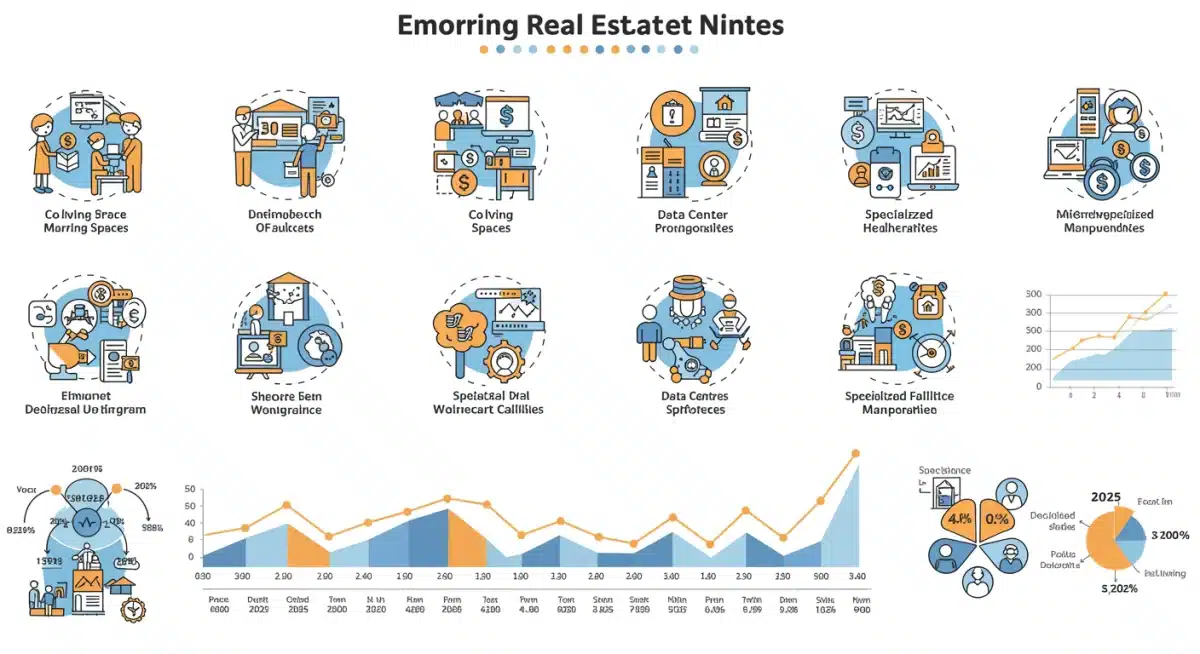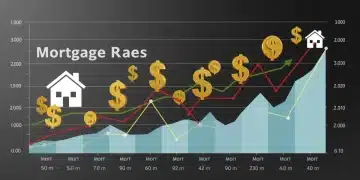Real Estate Investment 2025: Capitalize Emerging Niches

Real estate investment in 2025 demands a strategic focus on emerging market niches to maximize financial impact, driven by evolving demographics and technological shifts.
As we approach 2025, the landscape for Real Estate Investment in 2025: Capitalizing on Emerging Market Niches (FINANCIAL IMPACT) is rapidly evolving, presenting unique opportunities for astute investors. This developing scenario requires immediate attention to shifts in demographics, technology, and economic policy.
Understanding the 2025 Market Dynamics
The real estate market in 2025 is currently undergoing significant transformations, influenced by post-pandemic recovery, inflation, and shifting consumer behaviors. Investors are observing a recalibration of value in traditional sectors, prompting a search for new avenues of growth and stability.
According to recent reports from the National Association of Realtors, traditional residential and commercial segments are facing headwinds, as of October 26, 2024. This necessitates a proactive approach to identify and capitalize on less conventional, yet highly promising, market niches.
Key Economic Indicators to Watch
Several economic indicators are pivotal in shaping the 2025 real estate investment climate. Interest rate movements, inflation trends, and employment figures are directly impacting borrowing costs and consumer purchasing power.
According to recent reports from the National Association of Realtors, traditional residential and commercial segments are facing headwinds, as of October 26, 2024. This necessitates a proactive approach to identify and capitalize on less conventional, yet highly promising, market niches.
Key Economic Indicators to Watch
Several economic indicators are pivotal in shaping the 2025 real estate investment climate. Interest rate movements, inflation trends, and employment figures are directly impacting borrowing costs and consumer purchasing power.
- Interest Rates: Continued monitoring of central bank policies is crucial, as rate hikes can cool overheated markets.
- Inflation: High inflation erodes purchasing power but can also drive up property values, creating mixed effects.
- Employment Growth: Strong job markets typically correlate with increased demand for both residential and commercial properties.
The Rise of Specialized Housing Segments
Specialized housing is emerging as a dominant niche for Real Estate Investment in 2025: Capitalizing on Emerging Market Niches (FINANCIAL IMPACT). This sector includes properties tailored for specific demographic groups or unique living arrangements, offering resilient returns.
With an aging global population and evolving lifestyle preferences among younger generations, traditional housing models are being supplemented by more targeted solutions. These segments often demonstrate lower vacancy rates and higher rental yields due to their specific demand drivers.
Senior Living Facilities
The demand for senior living facilities continues to surge as the baby boomer generation ages. These properties range from independent living communities to assisted living and memory care units, each offering distinct investment profiles.
Investment in senior living is considered a defensive play, as demand is less susceptible to economic downturns. Operators report consistent occupancy, even during periods of broader market volatility.
- Demographic Tailwinds: The 65+ population is projected to grow significantly through 2030, ensuring sustained demand.
- Healthcare Integration: Facilities offering integrated healthcare services command higher premiums and attract more residents.
- Technology Adoption: Smart home technologies and telehealth services enhance resident experience and operational efficiency.
Data Centers and Digital Infrastructure
The relentless growth of digitalization, artificial intelligence, and cloud computing is fueling unprecedented demand for data centers, positioning them as a prime target for Real Estate Investment in 2025: Capitalizing on Emerging Market Niches (FINANCIAL IMPACT). This specialized infrastructure is critical for the global digital economy.
Data centers require significant capital expenditure but offer long-term leases with high-credit tenants, providing stable and predictable income streams. The technical complexity and specialized nature of these facilities create high barriers to entry, limiting competition.
As reported by industry analysts at Cushman & Wakefield as of late October 2024, global data center capacity is expanding at an accelerated pace, particularly in tier-two cities and emerging tech hubs. This expansion is driven by the need for localized data processing and storage to reduce latency and improve service delivery.
Investment in Edge Computing Facilities
Edge computing, which involves processing data closer to its source, is a rapidly expanding sub-niche within the data center sector. These smaller, distributed facilities are becoming essential for applications requiring real-time data processing, such as autonomous vehicles and IoT devices.
Investors are increasingly looking at opportunities in edge data centers, which can be developed in a wider range of locations compared to traditional hyperscale facilities. This diversification can mitigate risks associated with geographical concentration.
- Growing Demand: The proliferation of IoT devices and 5G networks drives the need for localized data processing.
- Strategic Locations: Proximity to urban centers and industrial zones is critical for minimizing latency.
- High Barriers to Entry: Specialized infrastructure and technical expertise make it a challenging market for new entrants.
Logistics and E-commerce Fulfilment Centers
The continued boom in e-commerce, a trend solidified during the pandemic, ensures that logistics and fulfillment centers remain a high-growth area for Real Estate Investment in 2025: Capitalizing on Emerging Market Niches (FINANCIAL IMPACT). These properties are the backbone of modern supply chains.
Consumers’ expectation for faster delivery times is pushing retailers to optimize their distribution networks, leading to robust demand for strategically located warehouses, distribution centers, and last-mile delivery facilities. Vacancy rates in this sector remain historically low across most developed markets.
Automated Warehousing Innovations
The integration of robotics and automation within logistics facilities is revolutionizing the sector. Automated warehouses can process goods more efficiently, reducing labor costs and increasing throughput. This technological advancement is attracting significant investment.
Investors are seeking properties that can accommodate advanced automation systems, often requiring higher clear heights, reinforced floors, and specialized power infrastructure. These features add value and future-proof the investment against technological obsolescence.
- E-commerce Dominance: Online retail continues to expand, driving demand for efficient storage and distribution.
- Supply Chain Resilience: Companies are investing in diversified logistics networks to withstand disruptions.
- Urban Infill Locations: Last-mile delivery hubs in urban areas are critical for meeting rapid delivery expectations.

Healthcare Facilities Beyond Hospitals
Beyond traditional hospitals, a diverse array of healthcare facilities presents compelling opportunities for Real Estate Investment in 2025: Capitalizing on Emerging Market Niches (FINANCIAL IMPACT). This includes medical office buildings, urgent care centers, and specialized outpatient clinics.
The shift towards outpatient care, driven by cost containment and technological advancements, is increasing the need for conveniently located and modern healthcare properties. These assets often benefit from long-term leases with stable tenants, offering predictable cash flows.
Outpatient and Urgent Care Facilities
Urgent care centers and specialized outpatient clinics are growing rapidly, providing accessible and cost-effective alternatives to emergency rooms. These facilities are often situated in retail-friendly locations, emphasizing patient convenience.
Investment in these facilities is attractive due to their essential service nature and insulation from broader economic cycles. The fragmented nature of healthcare delivery also allows for diverse investment strategies, from single-tenant properties to larger medical campuses.
- Cost-Effective Care: Outpatient services reduce healthcare costs, driving patient and provider preference.
- Accessibility: Convenient locations improve patient access and utilization rates.
- Technological Advancements: Modern medical equipment and diagnostic tools require specialized facility designs.
Co-living and Flexible Workspaces
The evolution of urban living and working patterns continues to fuel the expansion of co-living and flexible workspace models, marking them as significant niches for Real Estate Investment in 2025: Capitalizing on Emerging Market Niches (FINANCIAL IMPACT). These concepts cater to a workforce seeking flexibility and community.
Co-living offers furnished private bedrooms within shared communal spaces, appealing to young professionals and digital nomads. Flexible workspaces, including co-working spaces and serviced offices, provide adaptable environments for businesses of all sizes, reducing long-term lease commitments.
The Hybrid Work Impact
The widespread adoption of hybrid work models has fundamentally reshaped office demand. Companies are now seeking flexible office solutions that can adapt to fluctuating employee presence and collaborative needs. This has boosted the appeal of co-working operators.
Investors are focusing on properties that can be easily reconfigured to support various work styles and community-centric amenities. The ability to offer short-term leases and diverse membership options provides operators with pricing power and resilience.
- Urbanization Trends: Young professionals continue to seek affordable, community-oriented living in urban centers.
- Workplace Flexibility: Businesses prioritize agile office solutions that support hybrid work models.
- Amenity-Rich Environments: Properties offering shared amenities and services enhance tenant attraction and retention.
Navigating Risks and Opportunities in Emerging Niches
While emerging real estate niches offer substantial growth potential, investors must also carefully navigate inherent risks. Market volatility, regulatory changes, and the specialized nature of these assets demand thorough due diligence and strategic planning for Real Estate Investment in 2025: Capitalizing on Emerging Market Niches (FINANCIAL IMPACT).
Understanding the specific demand drivers, operational complexities, and potential exit strategies for each niche is paramount. Diversification across different emerging sectors can help mitigate overall portfolio risk.
Mitigating Investment Risks
Successful investment in emerging niches hinges on robust risk management. This involves detailed market research, partnering with experienced operators, and understanding the regulatory environment specific to each asset class.
For instance, data centers face risks related to technological obsolescence and energy costs, while senior living facilities are subject to healthcare regulations and staffing challenges. A comprehensive understanding of these factors is critical for long-term success.
- Thorough Due Diligence: Conduct in-depth analysis of market demand, competition, and operational viability.
- Regulatory Compliance: Stay informed about evolving regulations specific to each niche, such as healthcare or data privacy.
- Partnership Selection: Collaborate with experienced developers and operators who have a proven track record in specialized assets.
| Key Niche | Brief Description |
|---|---|
| Senior Living | Growing demand driven by aging demographics, offering stable, defensive returns. |
| Data Centers | Essential digital infrastructure with long-term leases and high barriers to entry. |
| Logistics & Fulfilment | E-commerce driven demand for warehouses, especially automated and last-mile facilities. |
| Co-living & Flex Work | Catering to urban living and hybrid work, offering flexibility and community. |
Frequently Asked Questions About Real Estate Investment in 2025
The primary drivers include demographic shifts, particularly an aging population and evolving millennial preferences, alongside rapid technological advancements like AI and e-commerce growth. These factors are reshaping demand for specialized properties, moving away from traditional models.
Interest rates significantly influence borrowing costs and investor returns. Higher rates can increase financing expenses, potentially reducing profit margins, while lower rates can stimulate investment. Monitoring central bank policies is crucial for strategic decision-making in 2025.
Data centers are generally considered a robust investment due to persistent demand for digital infrastructure. While technology evolves, the fundamental need for data storage and processing remains. Investing in modern, adaptable facilities and partnering with experienced operators can mitigate obsolescence risks.
Sustainability is increasingly vital. Properties with green certifications and energy-efficient designs attract tenants, reduce operational costs, and often command higher valuations. Investors are prioritizing ESG (Environmental, Social, Governance) factors, aligning with growing regulatory and consumer demand for sustainable assets.
Identifying the best niches involves thorough market research, analyzing demographic trends, technological adoption rates, and local economic growth. Consulting with real estate experts, monitoring industry reports, and understanding specific regional demands are critical steps for informed decision-making.
Looking Ahead
The ongoing developments in global economic policy and technological innovation continue to reshape the real estate sector. Investors must remain agile, focusing on strategic diversification into these identified emerging niches. The financial impact of these shifts will be profound, rewarding those who adapt quickly and judiciously. Expect further announcements from major investment firms regarding expanded portfolios in these specialized areas as 2025 unfolds, indicating a clear trend towards targeted asset acquisition.





